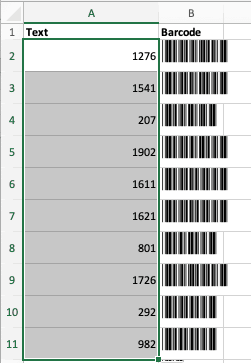

It is a square in shape code and can encode large – as in huge – amounts of informaton in a very small space it is very popular in electronics manufacturing and healthcare for that reason. This has become one the most common 2D barcodes. However, it can be expansive in size – 4 times larger than other 2D barcodes such as Datamatrix and QR Codes. It is the also the chosen standard by the USPS and Department of Homeland Security due to its advanced capabilities, such as encoding links to more than one data file. This stacked, linear 2D barcode can be found in many types of identification such as your driver’s license. Like UPCs, these are standardized for the unique identification of publishers. These 13-digit codes are created from the International Standard Book Numbers (ISBN) for each respective book tracked. Click here to learn more.Ĭonsidered a superset of the UPC, these barcodes are used specifically by booksellers, libraries, universities and wholesalers for book traceability. After securing a UPC number, a manufacturer will receive a unique company number to combine with their individual product numbers.

Click here to learn more.įound on nearly every retail product, these barcodes were originally created for grocery stores to provide quick receipt printing and inventory tracking.

The number of digits used must be even for this format to work, so a zero is commonly added at the end of an odd set of numbers. Every two digits are paired to create one symbol. Click here to learn more.Ĭommonly found in warehouse, distribution, and manufacturing, Code I 2 of 5 is a numeric-only barcode used to encode pairs of numbers. Code 128 features an automatic switching setting that allows users to optimize it for barcode length. Click here to learn more.ĭerived from the ASCII 128 character set (0-9, a-z, A-Z, and some special characters), this compact barcode is used extensively in packaging and shipping applications worldwide. If space is a concern, Code 128 would be a better choice to consider. It is a lineal, 1D, alphanumeric code with the ability to include the entire 128 ASCII character set and extend to any length, only limited by the size of the label. This is one of the oldest barcodes around and is a common symbology found in electronics, healthcare, and government. Why not learn more about how barcodes can better serve you? For instance, the recent surge of 2D barcoding has proven popular by allowing you to scan straight from your smartphone for a wealth of data. Barcode technology never stops advancing. Speaking Another Language: Barcode Symbologies differ in qualities such as capacity and linearity, making some advantageous for particular uses and industries. Each symbology follows an algorithm for standardizing the encoding and storing of these characters. Rather than manually writing and copying this information, it becomes encrypted in barcode languages (symbologies) for fast transfer through a scanner to computer. These strings of characters can designate all types of information.
#Numbers to barcode license#
They are basically a license plate that is linked to data files. Here’s an easy way to understand how barcodes work: think of them as a more technologically savvy way to transfer strings of characters. error correction, quiet zone and colors and build your Barcode for free.Barcode Types Explaining the Different Barcode types

#Numbers to barcode generator#
The last number is called a check digit which enables the scanner to determine if the barcode was scanned correctly.īarcode Generator tool is an easily and quickly way to generate your custom Barcode in over 70 formats. The next five digits represent the item's number. The first six numbers of the barcode is the manufacturer's identification number. There are two types of barcodes: linear – or 1D, and 2D. Their use has spread to many other tasks that are generically referred to as automatic identification and data capture (AIDC). Hence a barcode essentially is a way to encode information in a visual pattern that a machine can read.īarcodes became commercially successful when they were used to automate supermarket checkout systems, a task for which they have become almost universal. What is a Barcode? What is used for and how can you generate barcode?Ī barcode (also spelled bar code) is a method of representing data in a visual, machine-readable form.īarcode is a machine-readable code in the form of numbers and a pattern of parallel lines of varying widths, printed on a commodity.


 0 kommentar(er)
0 kommentar(er)
